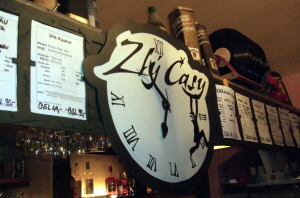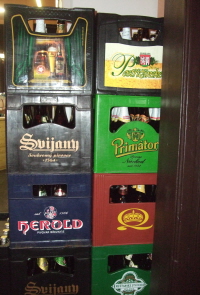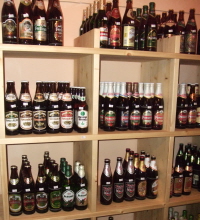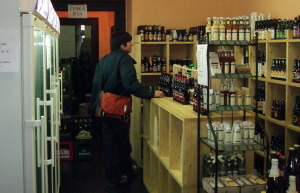Bohemia taught the world alot about brewing: now it seems the world is returning the compliment. On the simple wooden shelves of Pivkupectví, the bottle shop attached to one of Prague’s leading specialist beer pubs, Zlý Časy (Wicked Times), you’ll find an impressive range of serious craft beers from Belgium, France, Germany, the Netherlands, Scandinavia, the UK and the USA. They include selections from some of the world’s most talked about brewers: Amager, BrewDog, Mikkeller, Molen, Nøgne-Ø and Thiriez.
I wonder how easy it is to sell these beers, some of which cost Kč200 (£7, €8, $11.50) or more, in a city where you can buy a decent half litre of beer in a supermarket for Kč11 (40p, €0.45, 65¢). Helpful shop manager Dana tells me they do really well, with a core of regular customers — Czechs as well as the many visitors and expatriates in this cosmopolitan city — always on the lookout for something different and interesting.
It’s a remarkable development on a beer scene that, alongside its home country, has had an interesting century. The Czech lands spent several past centuries under the control of Austria’s Hapsburg dynasty, its southern German-speaking culture influencing brewing as it did many other aspects of life. Within this cultural sphere a belt of brewing cities, from Munich via Vienna to Prague and České Budějovice (Budweis) perfected the techniques of modern lager brewing in the first half of the 19th century, culminating in the celebrated golden lager of Plzeň that, as pilsner, provided the increasingly degraded template for the world’s most recognised beer style.
The Czech lands emerged from the meltdown of Austria-Hungary after World War I lumped together with neighbouring Slovakia as an independent nation. Nazi Germany’s annexxation of Czechoslovakia in 1938 formed a prelude to World War II, after which the country fell under the Soviet Union’s sphere of influence for several decades, becoming a ‘communist’ state with all industry nationalised.
Nationalisation can take some of the credit for ensuring the preservation of traditional brewing techniques which countries on the other side of the ‘Iron Curtain’ jetissoned, but the stifling grip of Stalinist bureaucracy stunted creativity and innovation, with some breweries restricted to only one standard beer. Then in 1989 came the Velvet Revolution, soon followed by the Velvet Divorce in which the Czech Republic and Slovakia went their separate ways.
The restoration of the capitalist market and the privatisation of most of the breweries hasn’t been an entirely positive experience from a beer point of view — the multinationals, attracted by a population that drinks more beer per head than any other in the world, soon swooped in, and there’s no doubt many of the estabished brewers’ products have lost character as a result. At the same time, though, the market has opened up space for small scale innovation and niche specialities.
In recent years that space has become increasingly occupied by new breweries that see themselves as part of the international craft brewing movement. Brewers like Kocour, Matuška and Staňkův take the best of the native tradition and styles and techniques inspired by other countries. They have an uphill struggle in convincing Czechs reared for decades on standard lager that there’s more to the world of beer, and in taking on the big brewers that control much of the licensed trade, but they’re tackling the project with gusto and some success, aided immeasurably by showcases like Zlý Časy, surely one of the world’s best beer pubs.
Owner Jan Charvát, a former vineyard manager who’d moved into running pubs, opened Zlý Časy in 2006, down a side street in the inner city district of Nusle, Prague 4 — not unpleasant and well located for the tram network, but a long way off the very well worn tourist trail of the famously beautiful Czech capital. In appearance this is in many respects a traditional small city pub with some quirky touches, tucked away in a cellar under a residential block, simply furnished in wood and serving up the substantial local version of pub grub.
At first its beer offer was traditional too but in January 2008, encouraged by the opening of new breweries and the glaring paucity of beer showcase outlets locally, Jan expanded the beer range dramatically. In July 2010 a shop, Pivkupectví, opened next door, with what’s almost certainly the best range in the city. “I genuinely think we’re the most exciting thing about beer in Prague right now,” says Jan, and he’s probably right.
The pub stocks up to 24 changing draught beers, mainly Czech but with the occasional German, all lovingly detailed (in Czech) on information sheets above the bar and below the distinctive Zlý Časy clock (they’re keen on their clocks in this part of the world). This is supplemented by a chiller cabinet with up to 50 beers from all over, culminating when I called with 330ml bottles of BrewDog’s Sink the Bismarck at Kč2099 (£75, €86, $120)!
The shop expands the range to 500 bottled beers, neatly packed on plain wooden shelves into a relatively small space and chosen, according to Jan, by drawing on the advice of beer rating websites and “barflies”. About two thirds are Czech, with a focus on smaller brewers. The new micros are well represented, but so are some of the best of the old established independent brewers: Černá Hora, Chodovar, Ferdinand, Janáček, Náchod Primátor, Opat, Pardubický, Svijanský and Vyškov are favourites.
The Belgians are mainly solid classics (Trappists, Rodenbach, Boon Oude Geuze) supplemented by the likes of De Ranke and Struise, and there’s a short but well chosen German choice including Schlenkerla Rauchbier and several unfiltered lagers and wheat beers. Americans are those now regularly imported into Europe — Anchor, Flying Dog, Great Divide, Left Hand, Sierra Nevada. Then there are the various Dutch, Scandinavian and Scottish beer geek pleasers mentioned earlier, a number of whom have collaborated with Czech brewers. Some of this comes courtesy of Mike Cole’s Czech-based importer Odddog, established in 2009, which is now also exporting Czech craft beers to the UK.
Then there’s gift boxes, glasses, the odd bit of breweriana and a curious range of handmade Czech beer cosmetics including bubble bath to help you recreate the experience of a beer spa at home. Once a year the pub and shop stage a microbrewery festival but otherwise there are not yet events and tastings.
Jan is optimistic, with the ultimate ambition to expand the range to 1,500 beers. “The situation is getting slowly better,” he tells me. “Microbreweries like Kocour are doing very exciting things, and Czech people are finding their way to the imported beers too.” The recent joint launch by a group of Prague pubs including Zlý Časy of the Aliance PIV (Intelligent Beer Bars’ Alliance) is helping provide a more general focus for the growing scene. It looks like the interesting times for Czech brewing will continue.
Researched September/December 2010. Thanks to Evan Rail for his advice and recommendations.
Fact file
Address: Čestmírova 5, 140 00 Praha 4
Tel: +420 723 339 995
Website: www.zlycasy.eu
Hours: Shop Mon-Fri 1300-2100; Pub Mon-Thurs 1100-2330, Fri 1100-0100, Sat 1700-0100, Sun 1700-2300
Drink in? In pub but not in shop
Mail order: Not yet
Manager’s favourites: Anything from Matuška, Struise Ignis et Flamma
Beer picks
- Bernard Sváteční Ležák 5%, Humpolec, Vysočina. Beautifully fresh and juicy bottle conditioned lager with a decent whole hop bite.
- Chodovar Zámecké Černé 4.2%, Chodová Planá, Plzeňský kraj. Soft, sweetish and caramel-tinged honestly malty dark lager.
- Kocour Weizenbock 6.6%, Varnsdorf, Ústecký kraj. Big tangy cloudy wheat beer with marmalade and spiced cake notes.
- Matuška Raptor IPA 6.2%, Broumy, Středočeský kraj. Impressive Czech interpretation of a Cascade-scented American IPA.
- Polička Záviš světlý ležák 12°5.2%, Polička, Pardubický kraj. Impressive unpasteurised premium lager with a citric, slightly oily note.
- Vyškov Jubiler 7.5%, Vyškov, Jihomoravský kraj. A fine strong celebration lager with apricottish estery hints.











Leave a Reply